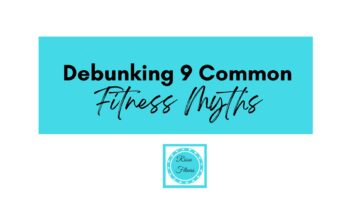
Here are nine common fitness myths that just need to die.
Eating Late at Night Causes Fat Gain
Many of my clients wrongly believe that eating late at night causes them to store body fat. However, this idea is simply untrue. The timing of your last meal does not have any effect on your overall weight and body composition. Instead, the number of calories you eat over the course of the day (and over a longer period of time) determines whether you gain or lose weight/fat. In short, it’s not when you eat, it’s how much you eat that matters.
Lift Light Weights to Tone and Heavy Weights to Build
First of all, you can’t “tone” your muscles at all. You can only build or lose muscle mass. To build lean muscle, you need to use weights that challenge you. You can also build muscle with light weights, but you have to approach muscle failure to create a muscle building stimulus. If you just fling around light weights without even approaching muscle fatigue, you won’t create any stimulus to build muscle.
Women will get Bulky Lifting Heavy Weights
It’s very rare and very difficult for women to gain appreciable muscle mass with a strength training routine. Most women do gain some muscle mass through consistent strength training, however often end up looking leaner due to a reduction in body fat due to regular training and dietary interventions. A bulky appearance is usually caused by too much body fat, rather than too much muscle mass. However, women won’t get bulky doing strength training.
Stick to the Fat Burning Zones
Many people stick to low and moderate intensity cardio to remain in the fat burning zone. Unfortunately, there is no magical fat burning zone. At any cardio activity, your body uses a combination of carbs and fat to supply energy. At lower intensities, your body relies on more fat and fewer carbs than at higher intensities.
However, it’s your total energy expenditure, rather than the percentage of fat, that you use during exercise that really matters. At higher intensities, you burn more calories overall and more total fat. If you want to maximize the calories you burn during cardio exercise, you should maintain the highest overall intensity you can instead of trying to stay in a mythical fat burning zone.
Sprints are Best for Fat Loss
Sprints are a high intensity, demanding activity that require significant recovery between sets and sprint sessions. While many people can safely do sprints, sprinting is not an appropriate activity for many people. More importantly, fat loss results from a calorie deficit from eating fewer calories than you burn over the long term. Sprinting–or any other exercise–isn’t technically necessary for fat loss.
You Can’t Build Muscle After 50
You can build muscle at any age. It’s never too late to pick up those weights or do a few sets of squats in front of your living room couch. Building muscle and strength well into your later years can help you slow down the aging process, maintain your independence, prevent falls, prevent muscle wasting, boost your metabolism and prevent bone loss across your lifespan. Strength training is vital for older adults.
Isolation Exercises Are Best for Sculpting Muscle
Isolation exercises are exercises that aim to isolate one muscle group at a time. In contrast, compound exercises train multiple muscle groups together. In truth, your program should prioritize compound exercises, instead of isolation exercises, to build muscle and strength.
Perform compound movements like squats, cleans, deadlifts, lunges, presses, rows, pull ups and push ups. Then sprinkle in leg extensions, lateral raises, rear delt flies and other isolation movements to bring up lagging body parts.
Split Body Part Routines are Superior for Muscle Gains
With split body part routines, you train one or two muscle groups per training session. With these programs, you tend to train each muscle group once or twice per week. Split body part routines are actually often inferior for muscle growth.
For natural trainees, full body or upper/lower routines allow you to train each muscle group 2-5 times per week. Training muscle groups more frequently allows you to stimulate muscle protein stimulus more often, typically resulting in more muscle gains. Full body or upper/lower routines are often also better for strength gains as you get more practice with specific movements. These types of workouts often allow you to get better quality workouts as you remain relatively fresh for all exercises. After all, it’s tough to preserve workout intensity on your seventh leg exercise of the day.
Lifting Weights is Dangerous
Lifting weights, even competitively, is safer than field sports, running and triathlon. You are less likely to get injured lifting weights than playing almost any sport. The injury rate for resistance training varies from .24 injuries per 1,000 hours of participation (bodybuilding) up to a high of 2.4-3.3 injuries (Olympic weightlifting) and 1.0-4.4 injuries per 1,000 hours of participation (powerlifting) versus about 10 injuries per 1,000 hours of recreational running.
Lifting weights can also reduce your risk of injury if you do decide to participate in running or other sports. If you are concerned about getting injured, consider working with a qualified personal trainer to learn proper technique and create a well balanced resistance training program that is tailored to you.